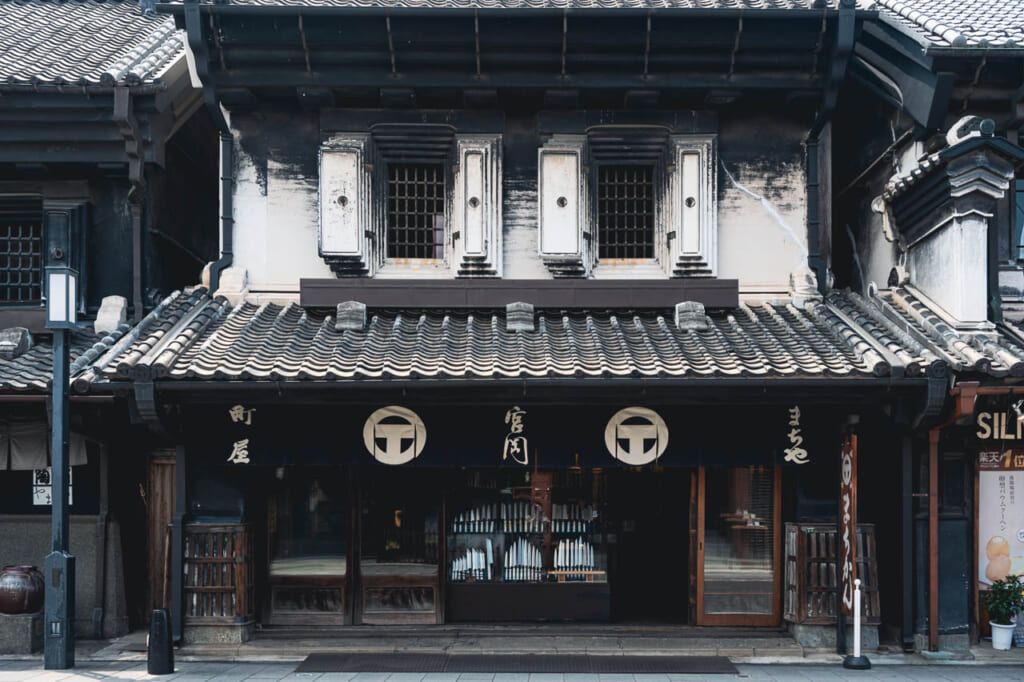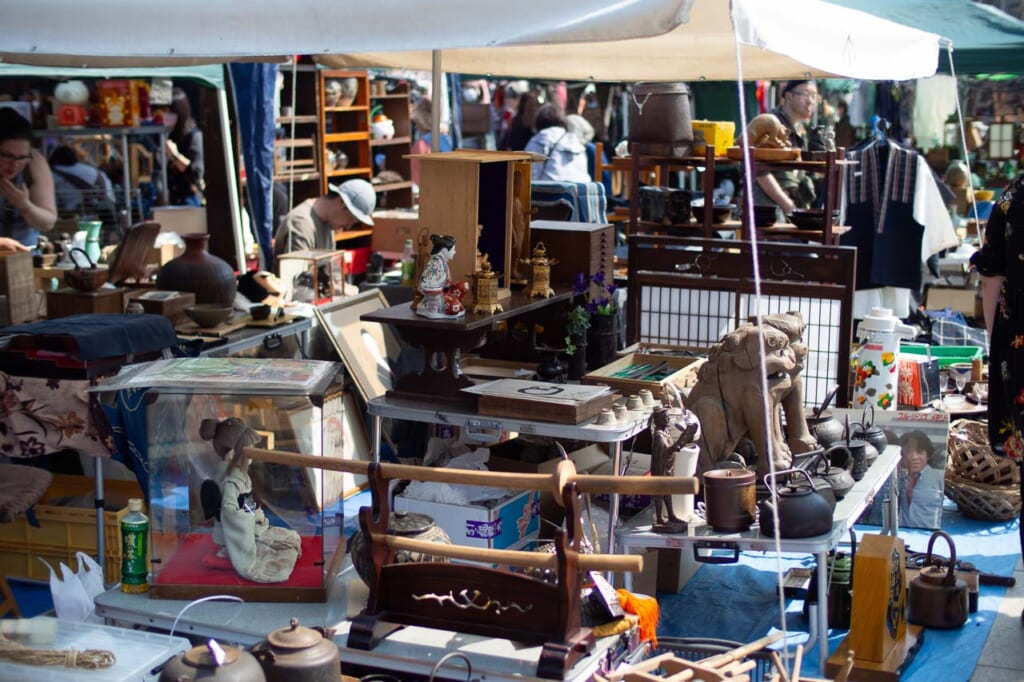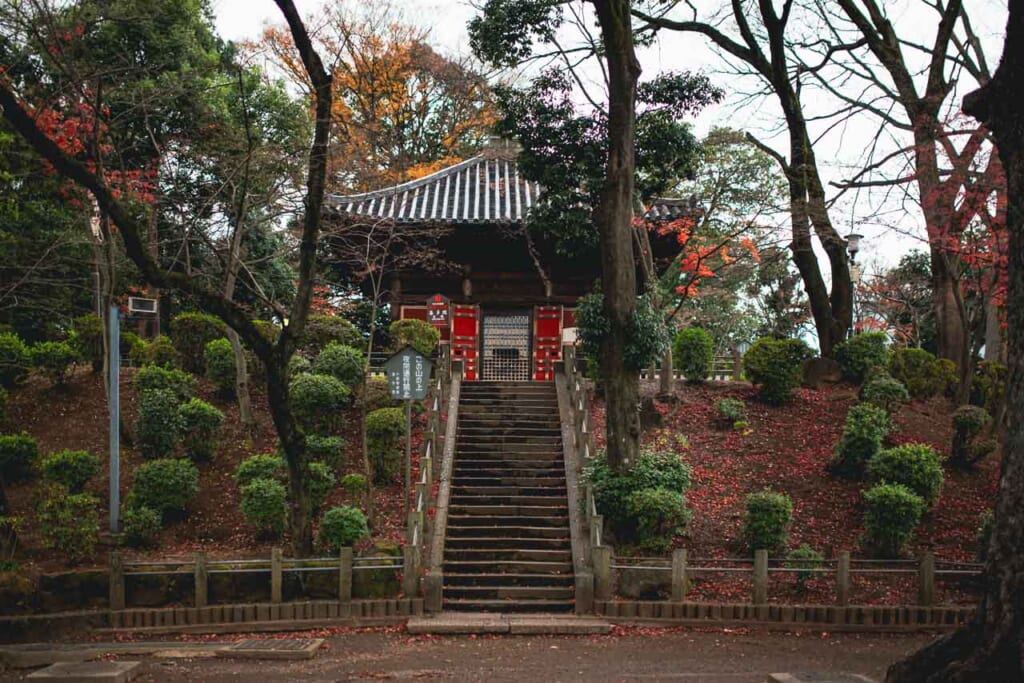Along Kawagoe’s famous Kurazukuri no Machinami street, the scars of the city’s long and often tragic history are evident. Many of these kurazukuri, two-story warehouses of thick clay walls, bear the blackened marks of huge fires that ravaged Kawagoe centuries ago. Ironically, the lessons of the fires shaped this now postcard-perfect urban landscape into what it has become: a popular day trip destination for both locals and visitors from Tokyo.
Walking along the narrow streets, now lined with these fireproof buildings and newer structures built to fit the historical atmosphere, visitors can be found strolling in rented kimono, enjoying an endless array of local snacks dispensed by vendors cheerfully calling out to the crowds, and becoming part of a scene that has all but disappeared from modern Tokyo. That’s why this quaint city in Saitama is known as Koedo, the “Little Edo” of Japan.
- A Brief History of Kawagoe
- How to Get to Kawagoe from Tokyo
- A Simple Day Trip Walking Itinerary of Kawagoe
- Taisho-Roman Street: A Walk Along Art Deco Style Architecture
- Kurazukuri no Machinami: Kawagoe’s Well-Preserved Historic Streetscape
- Toki-no-Kane Tower and Kawagoe’s Famous Starbucks
- Kashiya Yokocho: Traditional Candy Shops and Souvenir Shopping
- Kawagoe Hikawa Shrine: A Popular Spot for Kimono Photoshoots
- Ruins of Kawagoe Castle: Home to Kawagoe’s Castle Lord
- Kitain Temple and Semba Toshogu Shrine: Cherry Blossoms and Antique Markets
- Return to Kawagoe or Hon-Kawagoe Station
A Brief History of Kawagoe
Kawagoe’s history reaches as far back as Tokyo’s; it’s safe to say that ancient Kawagoe was at least as important as old Edo (Tokyo’s former name). Two of Kawagoe’s most important religious sites, Kitain Temple and Hikawa Shrine, were established 1,200 and 1,500 years ago, respectively, when Tokyo was nothing but a village by the sea.

Kawagoe became a castle town in the mid-15th century, and the lordship of the castle changed hands numerous times during its tumultuous history. When Tokugawa Ieyasu finally united Japan in 1603, the fortunes of Kawagoe began to follow the prosperity of the new capital of Edo. Kawagoe thrived as a merchant town producing textiles, rice, and other important commodities. It was connected by a main road known as the Kawagoe Kaido (highway). The rivers flowing through Kawagoe and Edo were also used as transportation routes for goods produced in Kawagoe.


Kawagoe enjoyed great favor from the Tokugawa Shogunate, another factor in its thriving history. Tokugawa Ieyasu had a strong relationship with the head priest of Kitain Temple, who made it the head temple for Tendai Buddhism in the region. Years later, Ieyasu’s grandson, Iemitsu, the third Tokugawa Shogun, would frequent Kawagoe as his favored hunting grounds. The Shogunate’s most trusted allies were given positions as lords over Kawagoe, and the region enjoyed tremendous prosperity and protection from their rule.


However, nothing could protect the city from devastating fires, common destroyers of major cities in that era. The first Great Fire of Kawagoe occurred in 1638 and destroyed most of the town around the castle. However, the wise Lord Matsudaira Nobutsuna seized the opportunity to reorganize and rebuild the town into a structure that enabled it to thrive for centuries. Three more huge fires ravaged the city during the Meiji period (1868-1912), including one in 1893 that destroyed a quarter of the town’s structures. City residents took lessons from the fires and rebuilt the city into the landscape visitors see today.
The best way to understand Kawagoe’s history is by walking tour. As a relatively flat and compact city, Kawagoe is easily walkable in just a few hours at a leisurely pace. Let’s take a walk around this historical city to enjoy its authentic traditional sights.
How to Get to Kawagoe from Tokyo
First, you’ll need to get to Kawagoe from nearby Tokyo. Several train lines serve Kawagoe from central Tokyo: the JR Saikyo/Kawagoe Line, Tobu Tojo Line, and Seibu Shinjuku Line. Each of these lines can get you from Tokyo to Kawagoe in an hour or less.
You can catch a train to Kawagoe at Shinjuku (JR Saikyo/Kawagoe), Seibu-Shinjuku (Seibu Shinjuku), or Ikebukuro (Tobu Tojo) stations. Get off the train at Kawagoe Station for the JR and Tobu Line trains and Hon-Kawagoe for the Seibu Line train.
A Simple Day Trip Walking Itinerary of Kawagoe
If you arrive at Kawagoe Station, you’ll start your tour a few hundred meters south of Hon-Kawagoe Station. Not to worry; you can enjoy a stroll through Crea Mall Street, a shopping district lined with shops, entertainment, and restaurants. Although not necessarily historic Kawagoe, it provides a nice atmosphere to enjoy the favorite Japanese pastimes of shopping and eating. Head north along the Crea Mall Street, and in 5-10 minutes, you’ll pass Hon-Kawagoe Station, where those arriving on the Seibu Line train will start their walking tour.
Taisho-Roman Street: A Walk Along Art Deco Style Architecture
Continuing north, you’ll reach the Taisho-Roman Dori (street) entrance, a street consisting of art deco-style buildings from around 1910-1930. You’ll see the stone torii gate entrance to Kawagoe Kumano Shrine just beyond the street entrance on the left. The shrine features the image of Yatagarasu, the three-legged crow messenger of the Shinto gods. You can engage in legal money laundering (washing, actually) in the small Zeniarai Benzaiten pond or get a free foot massage walking along the rocky acupressure pathways on the side of the walkway leading to the shrine.

With your clean (and lucky) money and freshly acupressured soles, continue along the Taisho Roman Dori. While several businesses here have existed from the 18th and 19th centuries, many of the buildings along this street were rebuilt during Japan’s Taisho period around the 1920s when Japan looked to the West for inspiration in architectural design. Architectural history buffs will see plenty of the Art Deco style in the details of many buildings. Down one of the side streets, you’ll also find a giant replica of a sweet potato, Kawagoe’s famous produce, outside the Hatago Hostel.
 Taisho Roman Yume-dori
Taisho Roman Yume-dori
TOURIST ATTRACTION- Japan, 〒350-0066 Saitama, Kawagoe, Renjakucho, 17−1
- ★★★★☆
Kurazukuri no Machinami: Kawagoe’s Well-Preserved Historic Streetscape
At the end of Taisho Roman Dori, make a quick left, and you’ll soon spot the unmistakable historical landscape of Kurazukuri no Machinami. The most renowned stretch of Kawagoe’s historical district stretches along the main street for several hundred meters heading north. Most buildings here were constructed in the kurazukuri style: thick, fireproof layers of clay and plaster rather than wood, which is the main reason they survived the deadly fires of the Meiji era.

It’s interesting to note that although the area is marketed as a townscape of the Edo period, most historical buildings here were built during the Meiji period following Edo. This is because residents soon realized after a major fire that the only structures that survived were constructed in the kurazukuri style, so new buildings replacing the ones that burned down were also constructed in that style until nearly the entire street was lined with them.
As expected in a touristy area, there is a broad mix of both authentic and made-for-tourist shops along this street. A few of the traditional highlights include Kanda, a kimono and accessory shop that deals in Kawagoe Tozan, a traditional and prized cotton fabric that was a significant city export. You’ll also find Kinbue Shoyu, one of three traditional soy sauce manufacturers (making soy sauce in wooden barrels and fermenting it for six months or longer) in Kawagoe still in operation. Craft beer lovers should be sure to sample Coedo, the local craft beer on tap at pubs like the Kawagoe Art Cafe Elevato.
 Ichibangai Shotengai
Ichibangai Shotengai
TOURIST ATTRACTION- Saiwaicho, Kawagoe, Saitama 350-0063, Japan
- ★★★★☆
 Kurazukuri Street
Kurazukuri Street
STORE- Saitama Prefectural Rd 12, Saiwaichō, Kawagoe, Saitama 350-0063, Japan
- ★★★★☆



The Kawagoe Festival Museum is also located on this street, and it is definitely recommended for those who cannot attend the real deal in October. The Kawagoe Festival is one of the best in the Kanto area, with elaborate floats, lively music, and an atmosphere that perfectly recalls the days of the Edo era.
 Kawagoe Matsuri Kaikan
Kawagoe Matsuri Kaikan
TOURIST ATTRACTION- Japan, 〒350-0062 Saitama, Kawagoe, Motomachi, 2 Chome−1−10
- ★★★★☆
Toki-no-Kane Tower and Kawagoe’s Famous Starbucks
Off of the main street, a popular side street leads to two of Kawagoe’s main attractions. The Toki-no-kane is a bell-tower structure that was part of Jorenji Temple. Built by a Kawagoe lord obsessed with punctuality, the tower eventually became a fire watchtower in 1733. Today, the image of the tower is the icon of Kawagoe City as its most recognizable landmark. A few doors down from Toki-no-kane is one of the more well-known locations of Starbucks Coffee. When the coffee giant started to make waves by building traditional Japan-inspired shops in Kyoto, this beautiful rendition of the ubiquitous coffee brand appeared on the Kawagoe scene. While the hype has mostly died down, it remains a lovely example of modern-traditional Japanese design and a nice place to relax especially if you’re a fan of Starbucks.

Just across the street from Starbucks is the Yugeta Shoyu soy sauce shop, another of Kawagoe’s three traditional soy sauce brewers. The small window facing the street sells soy sauce-flavored soft cream, one of my favorite Kawagoe snacks, and a treat to those who enjoy the flavor of salted caramel, which is the closest thing I can think of to it.
 Toki no Kane
Toki no Kane
TOURIST ATTRACTION- Japan, 〒350-0063 Saitama, Kawagoe, Saiwaicho, 15−7
- ★★★★☆
Kashiya Yokocho: Traditional Candy Shops and Souvenir Shopping
Near the end of Kurazukuri no Machinami, you’ll find Kashiya Yokocho, a narrow street lined with shops making and selling traditional candies. The lively atmosphere makes this a popular area for a stroll and picking up delicious souvenirs.
 Kashiya Yokocho
Kashiya Yokocho
TOURIST ATTRACTION- Japan, 〒350-0062 Saitama, Kawagoe, Motomachi, 2 Chome−11−3
- ★★★☆☆

Kawagoe Hikawa Shrine: A Popular Spot for Kimono Photoshoots
Take a 10-15 minute walk from here to Kawagoe Hikawa Shrine, the city’s oldest. The shrine was established in 540 and, even today is one of the area’s busiest shrines. This shrine holds many special seasonal events and is connected to the popular Kawagoe Festival. The shrine is very popular with those wearing kimono as it is a beautiful location to take photos, with cherry blossoms in the spring and a tunnel lined with ema prayer boards year round.
 Kawagoe Hikawa Shrine
Kawagoe Hikawa Shrine
TOURIST ATTRACTION- Japan, 〒350-0052 Saitama, Kawagoe, Miyashitamachi, 2 Chome−11−3
- ★★★★☆

Ruins of Kawagoe Castle: Home to Kawagoe’s Castle Lord
Another 10-minute walk southeast brings you to the remains of Kawagoe Castle. A single building remains here, the Honmaru Goten, where the castle lord once lived and conducted business. You can tour the building for a small fee, then stroll around the castle grounds, now primarily a public park, to imagine the grandeur of the former castle.
 Kawagoe Castle
Kawagoe Castle
TOURIST ATTRACTION- Japan, 〒350-0053 Saitama, Kawagoe, Kuruwamachi, 2 Chome−13−番地
- ★★★☆☆
Kitain Temple and Semba Toshogu Shrine: Cherry Blossoms and Antique Markets
It is about a 15-minute walk from the castle to Kitain Temple, once a favored temple of the Tokugawa Shogunate. A slight detour will also take you near Naritasan Kawagoe Betsuin Hongyoin, a branch of the Naritasan Temple in Narita, near the international airport. The main attraction of this temple occurs on the 28th of each month when a sizeable antique market is held on the temple grounds. If you visit on this day, visiting this temple is a must (preferably as early as possible, as the antique fair winds down in the early afternoon).

Kitain’s spacious grounds and numerous important cultural artifacts make it a lovely place for a stroll and, during cherry blossom season, for locals to enjoy a hanami picnic under the blossoms. Although the temple’s history is long and storied, it thrived under the leadership of Tenkai Sojo, a monk who was a trusted advisor to Tokugawa Ieyasu. The Shogun consulted with Tenkai on the construction of Edo, which grew powerful during his rule and was credited to Tenkai’s wisdom.

On Ieyasu’s funeral procession to his final resting place in Nikko, the Tokugawa clan honored Kitain by holding a memorial at the temple. A statue of Ieyasu was enshrined at Kitain in the Semba Toshogu Shrine, an Important Cultural Property of Japan.

You’ll also find 500 rakan, small stone statues representing the Buddha, in a small courtyard of the temple accessible with a small admission fee. Each rakan has unique facial expressions; you might even find one that looks like you.
Admission to the courtyard also allows you to access buildings previously part of Edo Castle. The third Shogun, Iemitsu, moved the buildings here in 1638, which unintentionally spared them from destruction in the Great Kanto Earthquake and resulting fires of 1923. As such, these are the only remaining buildings left from Edo Castle.
 Semba Tōshō-gū
Semba Tōshō-gū
TOURIST ATTRACTION- Japan, 〒350-0036 Saitama, Kawagoe, Kosenbamachi, 1 Chome−21−1
- ★★★☆☆
Return to Kawagoe or Hon-Kawagoe Station
You’re in the home stretch now as you walk back to the station you originated from, 10 to 20 minutes, depending on whether your destination is Hon-Kawagoe or Kawagoe Station.

If you still need souvenirs or snacks along your route, make a quick stop at the Koedo Kurari complex. This former brewery features a restaurant and shops with locally produced products containing samples of nearly all the foods and products Kawagoe is renowned for, including one building dedicated to locally produced sake.
Of course, this is just a sample walking tour of Kawagoe’s most well-known attractions. This is a city that begs to be explored, discovering unique little shops and restaurants and beautiful, quiet spaces that are hard to find in big cities like Tokyo. So explore Kawagoe at your own pace, but whatever you do, take time to visit this gem just outside of Tokyo on your visit to Japan.













No Comments yet!